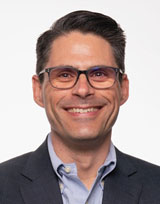
Government agencies need satellite data — to predict the weather, help farmers maximize crop yield and track ground cover for wildfire mitigation. “These are things that directly connect to what Americans do every day,” said ERT CEO Mark Lee.
Agencies require robust technology and infrastructure to support this immense amount of information.
“They need efficient and reliable ground station operations so they can communicate with their satellite constellations, make sure that they’re in the right places, that they’re secure, that the data are being transmitted back effectively,” Lee said.
ERT answers that call, ensuring end users have access to technology to process reliable, timely Earth science data.
“We don’t build satellites. We don’t build instrumentation, and we’re not involved in the satellite launches. Once those satellites are in space, however, we handle everything to do with their missions: Where they are, what they’re collecting, how secure they are, how the data gets sent back to Earth,” he said.
Once the data reaches Earth, ERT scientists help turn it into the data mapping and analysis products that can then be used by the government or by citizens to drive decisions.
For example: Every year the National Oceanic and Atmospheric Administration tracks seasonal weather patterns and generates forecasts that help Americans understand when and where we might have heavy snowfalls, what rainfall patterns farmers can anticipate, and how active we expect the hurricane season to be. ERT’s scientists “play a critical role in the development of these forecasts,” Lee said.
A number of strategies help the company stand out in this space.
“We compete against a lot of really large companies, and they obviously have lots of resources,” he said. “But being a midsize has advantages of its own. We are very focused. Our clients know what we do, they know what they can expect from us, and they know we bring a deep understanding of their mission.”
That smaller size drives agility, too. “As new technologies arise, as you’re dealing with new situations — right now, for example, there’s a huge emphasis on finding efficiencies — we’re much nimbler than a lot of our competitors,” Lee said. “And all of our major clients have my cell phone number. If something comes up, they know they can get in touch with the CEO and their issues will get addressed.”
All of this together “contributes to the ability to drive a really strong culture within the organization,” he said. “Our staff knows that we really value science and engineering and technology. And the proof is in the pudding. Our voluntary turnover rates are about half the industry average.”
As he looks to grow the business, Lee is taking a multipronged approach.
ERT’s biggest client is NOAA and he’s always looking to deepen that relationship. “We’ve also been working with NOAA for over 25 years, and there’s certainly a lot of opportunity there for us to continue to expand,” he said.
At the same time, “we’re interested in expanding into new client markets. There are a lot of other clients that would really benefit from working with ERT,” he said. “We’re very focused on building on our work at NASA and expanding more into Space Force, Air Force, and Navy. We would like to have a bigger presence within the DOD market.”
He’s also eyeing potential M&A activity. “That is absolutely a part of our playbook,” he said. “A good balance of organic and inorganic growth can build a really special company.”
Lee came to ERT after a 25-year run with ICF. He made some changes in going from a billion-dollar, publicly held company to a privately held firm with 600 employees.
“I had a wonderful ride at ICF,” he said. “It’s a company that gave me so much opportunity, and there are so many people there that I still think so highly of. But I was ready to have my hands on all the levers. I have ideas of how things can be done, and I am ready to try some of that out.”
He said the move has given him a chance to focus less on policy and program implementation, and get deeper into the things that really excite him: The science, engineering, and technology. “And it is nice being at a smaller place where change can happen more quickly. If we have a new idea, it’s not years to get it implemented. It could be weeks or months, and that is energizing to me,” he said.
“I am a scientist by nature, by education,” he said. “With science, there is a truth, there is an absolute. We’re trying to get to the right answer, and there is a right answer. I really am motivated by that quest for truth, that quest for what’s real.”
He takes pleasure, too, in working around like-minded folks.
“Being at a place like ERT, I get to surround myself with people who are similarly wired,” he said. “I love being around people who want to do these kinds of things — people who want to make a difference. It’s inspiring.”

